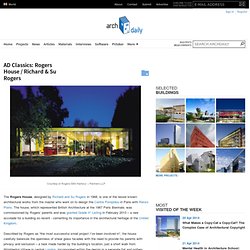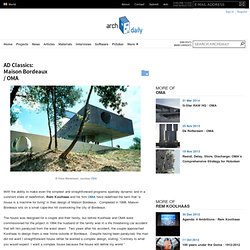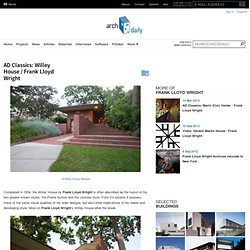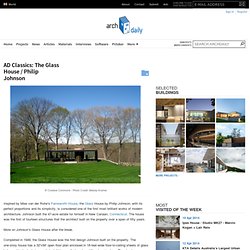

Gehry Residence / Frank Gehry. When Frank Gehry and his wife bought an existing house in Santa Monica, California, the neighbors did not have the slightest idea that the corner residence would soon be transformed into a symbol of deconstructivism.

Gehry, however, knew something had to be done to the house before he moved in. His solution was a bold one in the 1970′s that involved the “balance of fragment and whole, raw and refined, new and old” and would strike up controversy. More on Gehry’s Residence after the break. Gehry actually did keep the existing house almost completely in tact, but not in a conventional manner. AD Classics: Rogers House / Richard & Su Rogers. The Rogers House, designed by Richard and Su Rogers in 1968, is one of the lesser known architectural works from the master who went on to design the Centre Pompidou in Paris with Renzo Piano.

The house, which represented British Architecture at the 1967 Paris Biennale, was commissioned by Rogers’ parents and was granted Grade II* Listing in February 2013 – a rare accolade for a building so recent - cementing its importance in the architectural heritage of the United Kingdom. Described by Rogers as “the most successful small project I’ve been involved in”, the house carefully balances the openness of shear glass facades with the need to provide his parents with privacy and seclusion – a task made harder by the building’s location, just a short walk from Wimbledon Village in central London. AD Classics: Wall House 2 / John Hejduk. With a history unlike any other, Wall House 2 redefines the limits of architectural design as a function of context in both time and culture. 28 years after the completion of the initial designs and one year after the death of architect John Hejduk, construction began in a completely different environment than where it was initially imagined.

The house is a study of the relationship between inside and outside and is reminiscent of Corbusian architecture, although a bit more eccentric. More on the history of Wall House 2 after the break. The residence was initially designed by American architect John Hejduk in 1973 for a fellow faculty member at the Irwin S. Chanin School of Architecture at the Cooper Union in New York, to be constructed in Ridgefeld, Connecticut.
Due to the high estimated costs of construction in the wooded area, the project was put on hold. Organized around a central axis of horizontal and vertical plane, a three-dimensionality allows for experiencing the spaces. AD Classics: Maison Bordeaux / OMA. With the ability to make even the simplest and straightforward programs spatially dynamic and in a constant state of redefinition, Rem Koolhaas and his firm OMA have redefined the term that “a house is a machine for living” in their design of Maison Bordeaux.

Completed in 1998, Maison Bordeaux sits on a small cape-like hill overlooking the city of Bordeaux. The house was designed for a couple and their family, but before Koolhaas and OMA were commissioned for the project in 1994 the husband of the family was in a life threatening car accident that left him paralyzed from the waist down. Two years after his accident, the couple approached Koolhaas to design them a new home outside of Bordeaux. AD Classics: Fallingwater House / Frank Lloyd Wright. In Mill Run, Pennsylvania in the Bear Run Nature Reserve where a stream flows at 1298 feet above sea level and suddenly breaks to fall at 30 feet, Frank Lloyd Wright designed an extraordinary house known as Fallingwater that redefined the relationship between man, architecture, and nature.

The house was built as a weekend home for owners Mr. Edgar Kaufmann, his wife, and their son, whom he developed a friendship with through their son who was studying at Wright’s school, the Taliesin Fellowship. The waterfall had been the family’s retreat for fifteen years and when they commissioned Wright to design the house they envisioned one across from the waterfall, so that they could have it in their view. Instead, Wright integrated the design of the house with the waterfall itself, placing it right on top of it to make it a part of the Kaufmanns’ lives.
More information, images, and a short video on Fallingwater after the break. AD Classics: Ennis House / Frank Lloyd Wright. While driving through the Los Angeles area, a look up into the hillside above Griffith Park and you’ll be feasting your eyes with beauty and intrigue of monumental proportion.

Near the top of Vermont Avenue sits the Ennis House done by Frank Lloyd Wright in 1924, which dominates its surroundings as a modular masonry structure composed of square concrete bricks. Its inspiration is rather obvious, as Wright’s love for Mayan art and architecture connects this residence to the culture’s highly ornamented, symmetric and organized structures. AD Classics: Willey House / Frank Lloyd Wright. Completed in 1934, the Willey House by Frank Lloyd Wright is often described as the fusion of his two greater known styles, the Prairie School and the Usonian style.

From it’s exterior it possess many of the same visual qualities of his older designs, but also other implications of his newer and developing style. AD Classics: Westcott House / Frank Lloyd Wright. One of the first and only examples of the Prairie Style in Ohio, the Westcott House became a significant work in the prescribed methodology of Frank Lloyd Wright’s architecture.

Completed in 1908 for Burton J. Westcott and his family after moving the Westcott Motor Company from Richmond, Indiana, the Westcott House is an early staple in Frank Lloyd Wright’s iconic detailing and integration of a building into its landscape. AD Classics: The Glass House / Philip Johnson. Inspired by Mies van der Rohe’s Farnsworth House, the Glass House by Philip Johnson, with its perfect proportions and its simplicity, is considered one of the first most brilliant works of modern architecture.

Johnson built the 47-acre estate for himself in New Canaan, Connecticut. AD Classics: Steel Pre-Fab Houses / Donald Wexler. For Donald Wexler modern architecture is simply the right way to design.

One of the true fundamental Modernist, Donald Wexler began his career working in the office of Richard Neutra. It was here that he became a true pragmatist, balking at any ideological rational for modernism and instead argue that his pursuit of modern design derives from its responsiveness to dynamic environmental, technological, and material conditions. Adaptability and flexibility, prominent aspects of Wexler’s personality, are values inherent in his conception of architectural space, systems, and materials. It was this approach to modern design that led Donald Wexler to be one of the pioneers in the exploration of pre-fabrication and the use of light steel framing for both commercial and residential. It was in the offices of Neutra that Wexler first gained interest in working with steel framing, having Neutra’s Lovell Health House considered to be the first steel-frame residence in America.
AD Classics: Almere House / Benthem Crouwel Architekten. Architects: Benthem Crouwel Architekten Location: Almere, The Netherlands Project Area: 65 sqm Project Year: 1984 Photographs: Courtesy of Benthem Crouwel Architekten The house was designed for an unusual homes competition held by De Fantasie in Almere. The brief was to design a house without taking into account current building regulations. All prize-winners were awarded a plot of land on loan for five years. This meant that the house and its foundations had to be easy to dismantle. AD Classics: Villa Mairea / Alvar Aalto. A collage of materials amongst the trunks of countless birch trees in the Finnish landscape, the Villa Mairea built by Alvar Aalto in 1939 is a significant dwelling that marks a transition from traditional to modern architecture. Built as a guest house and rural retreat for Harry and Maire Gullichsen, Aalto was given permission to experiment with his thoughts and styles, which becomes clear when studying the strangely cohesive residence.
More on Villa Mairea after the break. AD Classics: Muuratsalo Experimental House / Alvar Aalto. Soon after the passing of his wife in 1949, Alto began the design for a summer getaway for himself on the western shore of island Muuratsalo, Finland. Through the process of designing the house, it became an experimental study of materiality, architecture construction and philosophies. More on Alvar Aalto‘s Experimental House after the break. The most basic understanding of the house is it’s courtyard scheme which focuses inwards on the space while also directing careful views of the nearby Lake Paijanne.
The walls of this courtyard reflect the very nature of the experimental home, as there are more than fifty different types of bricks which are arranged in various patterns. This allowed Aalto to test the aesthetics of different arrangements while also monitoring how they reacted in the rough climate. Testing concepts like foundation systems, free-form brick construction, and passive solar heating, Aalto was comfortable exploring materiality because he only used the residence part time. AD Classics: Schwimmer House / John Lautner. One of the more inspirational and influential architects of the twentieth century, John Lautner was revered in the world of architecture and design throughout his sixty-year-long career.
Architects like Frank Lloyd Wright and Frank Gehry give a substantial amount of credit to Lautner, who influenced their designs and minds as architects. AD Classics: Villa Savoye / Le Corbusier. Situated in Poissy, a small commune outside of Paris, is one of the most significant contributions to modern architecture in the 20th century, Villa Savoye by Le Corbusier. Completed in 1929, Villa Savoye is a modern take on a French country house that celebrates and reacts to the new machine age. The house single handedly transformed Le Corbusier’s career as well as the principles of the International Style; becoming one of the most important architectural precedents in the history. Villa Savoye’s detachment from its physical context lends its design to be contextually integrated into the mechanistic/industrial context of the early 20th century, conceptually defining the house as a mechanized entity.
Le Corbusier is famous for stating, “The house is a machine for living.” In response to his aspirations and admiration of mechanized design, Le Corbusier established “The Five Points” of architecture, which is simply a list of prescribed elements to be incorporated in design. AD Classics: Maison de Verre / Pierre Chareau + Bernard Bijvoet. Designed by Pierre Chareau and Bernard Bijvoet, the Maison de Verre translated as “House of Glass,” is a milestone in early modern architectural design. AD Classics: Villa Roche / Le Corbusier. Designed 1923-1925 as a residence for Swiss banker Raoul La Roche, Villa Roche is the quintessence of Le Corbusier’s modern approach to housing. The Villa acted as an exhibition space for Mr. Roche’s collection of avant-garde artwork, and is a pure assemblage of spatial volumes that interlocks the dual programs of domicile and gallery. More on Villa Roche after the break. The promenade through Villa Roche plays a significant role in linking these two programs into one; its hierarchy is a theme inspired by Corbusier‘s visit to the Acropolis.
AD Classics: Casa Barragan / Luis Barragan. AD Classics: Casa Batlló / Antoni Gaudí. The inspiring imagination of Antoni Gaudí undoubtedly reveals itself in one of his most poetic and artistic designs for a building, Casa Batlló. His synthesis of animal shapes, vine-like curves, hints of bone and skeleton, and his use of lustrous colored bits of glazed ceramic and glass create a masterpiece that will forever astonish its observers. AD Classics: Rietveld Schroder House / Gerrit Rietveld. Still as visionary and eccentric as it was when it was built in the 1920s, the Schroder House by Gerrit Rietveld continues to impress architects and interior designers with its innovative solutions to prominent design questions of its time. AD Classics: Gwathemy Residence and Studio / Charles Gwathmey. Part of the New York Five, architect Charles Gwathey designed the Gwathmey Residence and Studio for his parents in 1965.
The house was located on a one-acre flat site on eastern Long Island, New York near the ocean surrounded by undeveloped land (this land was planned to be used for an addition to the house). As his first residential project, Gwathmey was given the freedom by his parents to have full control of the design as long as it was in their $35,000 budget. AD Classics: House VI / Peter Eisenman.
AD Classics: Kaufmann House / Richard Neutra. One of the most important architects of the 20th Century, yet often overlooked, Richard Neutra has been on the forefront of modern residential architecture. After moving to the United States from Vienna, Austria in 1923, Neutra worked with Frank Lloyd Wright and Rudolf Schindler until 1930 when he started his own practice.
One of Neutra’s several iconic projects is the Kaufmann House in Palm Springs, California. Completed between 1946-1947, the Kaufmann House was a vacation home for Edgar J. AD Classics: Lovell House / Richard Neutra. AD Classics: Malin “Chemosphere” Residence / John Lautner. AD Classics: Vanna Venturi House / Robert Venturi. AD Classics: Eames House / Charles and Ray Eames. AD Classics: Stahl House / Pierre Koenig. AD Classics: Neugebauer House / Richard Meier & Partners Architects. AD Classics: Rachofsky House / Richard Meier & Partners Architects. AD Classics: Douglas House / Richard Meier & Partners Architects. AD Classics: Miller House and Garden / Eero Saarinen. AD Classics: Gropius House / Walter Gropius. AD Classics: Landhaus Lemke / Mies van der Rohe. AD Classics: Villa Tugendhat / Mies van der Rohe. AD Classics: The Farnsworth House / Mies van der Rohe. AD Classics: Koshino House / Tadao Ando.
AD Classics: Prairie Chicken House / Herb Greene. AD Classics: Esherick House / Louis Kahn. AD Classics: Melnikov House / Konstantin Melnikov. Classic: Cordoba House / Emilio Ambasz. AD Classics: Milam Residence / Paul Rudolph.